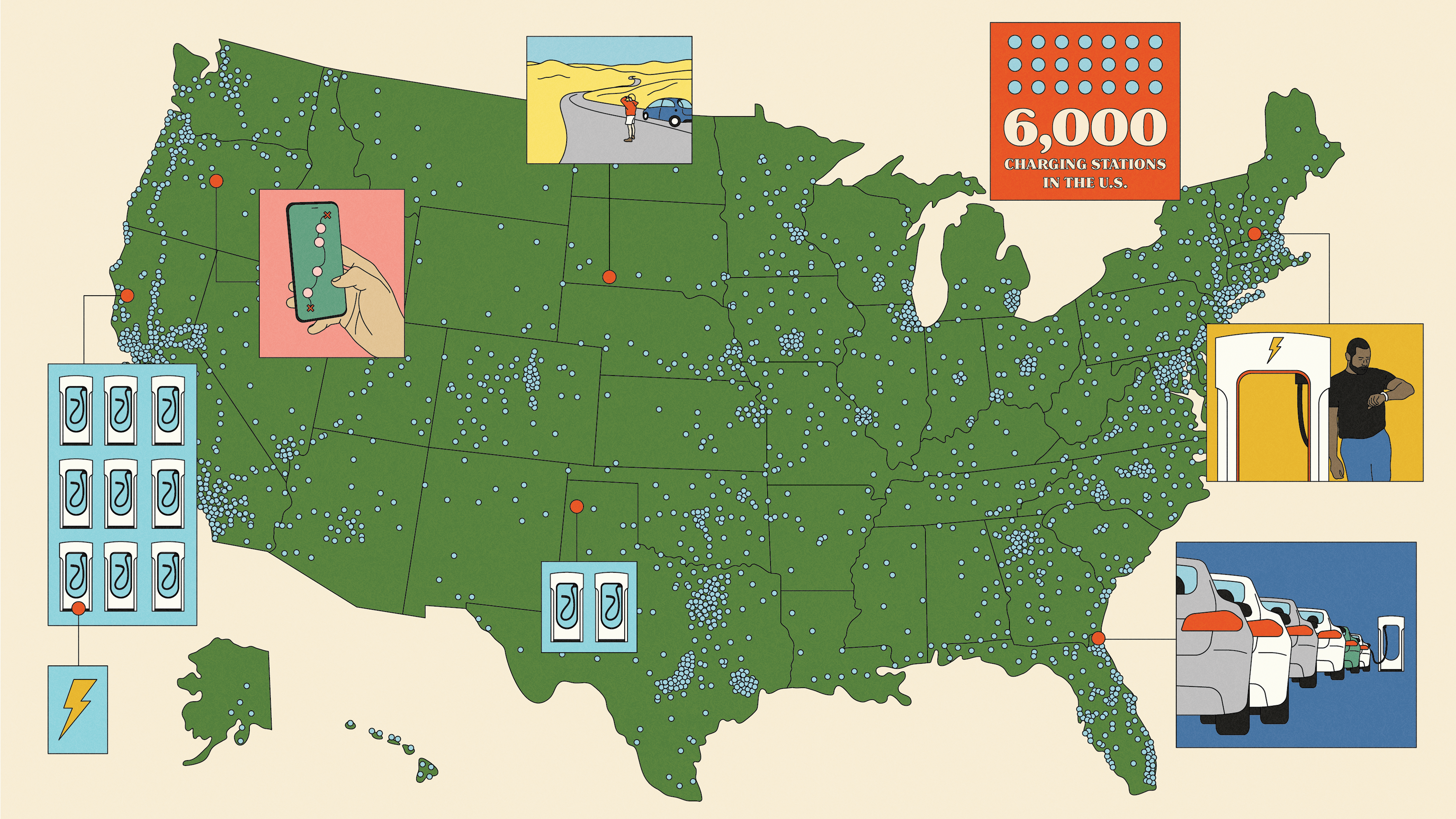The U.S. only has 6,000 fast charging stations for EVs. Here’s where they all are.
Electric vehicles appear poised to drive into the mainstream—but where will they plug in?

The United States has around 150,000 fuel stations to refill its fleet of fossil-fuel-burning vehicles. Despite the rapid growth of all-electric vehicles in America—400,000 of them were sold in 2021, up from barely 10,000 in 2012—the country has only 6,000 DC fast electric charging stations, the kind that can rapidly juice up a battery-powered car. (It has more than 48,000 charging stations of all kinds.)
A glance at America’s charging map reveals an abundance of charging deserts. This makes sense, as EVs still represent less than 3% of new car sales. Large cities have a growing number of fast chargers, but not nearly enough to accommodate a major influx of EVs. Away from cities, these chargers are strung along interstate highways closely enough to allow electric cars safe passage. Otherwise, they are nearly nonexistent in rural America. And EV stations have a problem that gas stations don’t: “Even the fastest Tesla supercharger is still going to take 15 minutes to put a couple hundred miles on the vehicle,” says Jeremy Michalek, a professor at Carnegie Mellon University and director of its Vehicle Electrification Group.
Michalek says American charging infrastructure lags far behind what’s needed for the whole country to transition to electric driving. On the bright side, there is time to catch up, because not all Americans will embrace EVs at once. Most early adopters were those with access to a charger at home in their garage or parking space. Those owners can wake up with a full battery and only need to rely on public chargers when they leave town on an extended trip. But as the country gets to higher levels of EV adoption, the current infrastructure won’t be enough. That is why Michalek says the US needs to prioritize bulking up the number of chargers at rest stops along well-traveled highways, especially as more people pile into electric cars for summertime road trips.
“As we get to higher levels of EV adoption, if we don’t have enough chargers for peak demand, the wait times are going to be unlike what we see with gas stations,” he says.
Charging dead zones will loom larger as more Americans consider an EV. Renters who do not have the option to install a home charger will be hesitant to go fully electric until they can feel confident a public plug will be there when they need it. And as more households drive only electric vehicles, it will be crucial that people can get to all the places they need (and want) to go.
The infrastructure bill that passed in November 2021 earmarked $7.5 billion for President Biden’s goal of having 500,000 chargers (individual plugs, not stations) around the nation. In the best case, Michalek envisions a public-private collaboration to build a robust national charging network. The Biden administration has pledged to install plugs throughout rural areas, while companies constructing charging stations across America will have a strong incentive to fill in the country’s biggest cities and most popular thoroughfares. After all, companies like Electrify America, EVgo, and ChargePoint charge customers per kilowatt-hour of energy they use, much like utilities.
Most new electric vehicles promise at least 250 miles on a full charge, and that number should keep ticking up. The farther cars can go without charging, the fewer anxious drivers will be stuck in lines waiting for a charging space to open. But make no mistake, Michalek says: an electric-car country needs a plethora of plugs, and soon.
Correction: The headline has been updated to reflect there are only 6,000 fast chargers. There are more than 48,000 chargers in total
Deep Dive
Climate change and energy
The problem with plug-in hybrids? Their drivers.
Plug-in hybrids are often sold as a transition to EVs, but new data from Europe shows we’re still underestimating the emissions they produce.
Harvard has halted its long-planned atmospheric geoengineering experiment
The decision follows years of controversy and the departure of one of the program’s key researchers.
Why hydrogen is losing the race to power cleaner cars
Batteries are dominating zero-emissions vehicles, and the fuel has better uses elsewhere.
Decarbonizing production of energy is a quick win
Clean technologies, including carbon management platforms, enable the global energy industry to play a crucial role in the transition to net zero.
Stay connected
Get the latest updates from
MIT Technology Review
Discover special offers, top stories, upcoming events, and more.